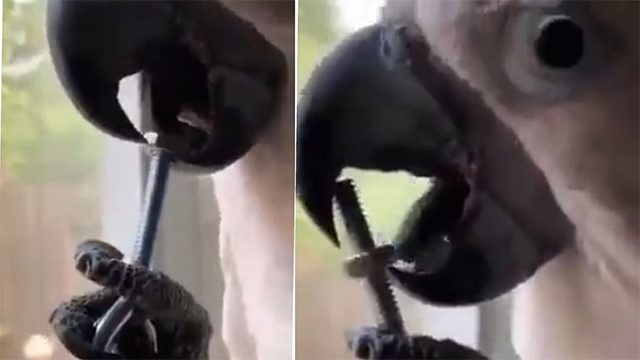A parrot has unexpectedly gained fame on social media for its impressive skill of unscrewing a bolt from a nut using its tongue, leaving viewers highly impressed.
We have known that parrots can mimic human speech, but in reality, these intelligent creatures can do much more than that.
In a short video shared on social media, a parrot surprised viewers by demonstrating its ability to unscrew a bolt from a nut at a speed comparable to that of a human using both hands.
To achieve this, the parrot uses its foot to hold one end of the screw tightly. Then, it uses its upper beak as a pivot to stabilize the screw while using its lower beak to position itself over the bolt on the screw. Once in position, the parrot repeatedly pushes its tongue against the bolt to unscrew it from the nut.
As the bolt nears its release from the nut, the parrot grips it tightly with its beak, seemingly attempting to pull it out with force, but initially fails. After several attempts, the parrot uses its tongue to finish unscrewing the bolt and successfully retrieves it.
Notably, the parrot’s level of proficiency suggests that it has performed this task many times before, leading observers to wonder how it learned to do this.

The parrot unscrewing a bolt from a nut at a speed comparable to that of a human
In fact, parrots are considered one of the most intelligent bird species, rivaling that of crows.
Neuroscientists have identified a special neural pathway in the brains of parrots, known as the intermediate spiral nucleus (SpM). This SpM region is responsible for transmitting information between the two largest areas of the brain, the cortex and the cerebellum, thereby creating complex cognition and behavior in birds.
Interestingly, the size of the SpM region in parrots is 2 to 5 times larger than in other bird species, which may explain their superior intelligence.
Additionally, unlike their relatives, parrots have developed a unique area connecting the cortex and cerebellum similar to that of primates. This is seen as a sign of cultural evolution—a concept mentioned by Charles Darwin in the 19th century.
For example, if a population of chimpanzees can learn honey-hunting techniques from one another and teach other chimps in the group to do the same, parrots may undergo a similar evolutionary process through observation.
This close observation is indicative of them passing on a skill through social learning or by watching humans perform their actions.





















































